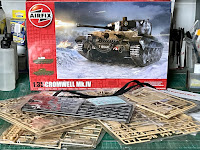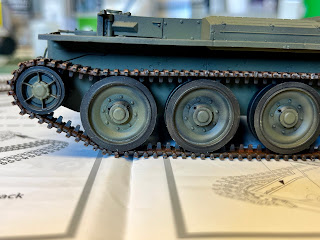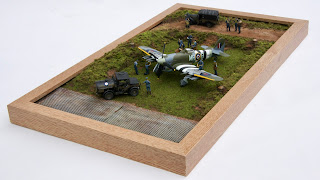Airfix 1:35 Cromwell Mk.IV and Bill Bellamy’s book: “Troop Leader, a tank commander’s story”.
Sunday, 28 April 2024
Cromwell Mk.IV
Wednesday, 24 April 2024
D-Day Air Assault
Airfix 1:72 D-Day Air Assault kit A50157A built to interpret ALG. B5/Le Fresne-Camilly, Normandy, France, home of Typhoon MN625 MR-B of No.245 (Northern Rhodesian) Squadron, 121 Wing, 2nd TAF. June 1944.
MN625 was flown by Fg.Off. W Smith who, on 10 June 1944, was made famous as being the first Allied pilot to land at one of the Advance Landing Ground (ALG) airfields in Normandy. This is how the Squadron’s Operations Book recorded it:
“At 0520 hours eight aircraft with R.P. and two fighters airborne to attack reported position of H.Q. Panzer Division. Intense flak of all types was encountered but despite this and much cloud the target was located and successfully attacked. F/O W.Smith was hit by flak and reported excessive vibration and much oil on the windscreen. He was instructed by W/Cdr. Green (who was leading) to put down on the ALG at Banville (B3/Ste Croix-sur-Mer) east of Bayeux. This he did successfully. He was met by a swarm of photographers and high officers who informed him that he was the first pilot to make a wheels down landing in France since D-Day. Apparently this honour was being saved for Air Vice Marshal Broardhurst who arrived some time later in a Spitfire!”
On 17th June, the Advance Landing Ground (ALG) B5/Le Fresne-Camilly was to be 245 Squadron’s new home. This was the fifth airfield to be established in the British and Canadian sector of the Normandy landings. Only about four miles inland from the invasion beaches, it had only recently been freed from shell-fire which had come from German units dug into surrounding woods.
The wire mesh strip or Square-Mesh Track (SMT) which served as a runway was over 5,500 feet long and ran from north to south along the plateau. Surrounding orchards were used to give cover for maintenance hangars and as dispersal points for aircraft requiring servicing. The main HQ was situated at the southern end of the runway and the three squadrons were dispersed to the east and west of it. Anti-aircraft defences were dug in around the perimeters, and slit trenches were adjacent to all working areas.
The observant may notice that I’ve used my Airfix Club kit/decals in this diorama as the one provided with the D-Day Assault kit were for an aircraft which took part in the September’s Operation Market Garden/A Bridge Too Far and not June’s Operation Overlord/The Longest Day
The final diorama
Friday, 19 April 2024
Sunday, 7 April 2024
Hawker Typhoon Mk.1b
I’m kicking off my D-Day 80th Anniversary builds with two of Airfix’s 1:72 scale Hawker Typhoons. One from the 2024 Airfix Club D-Day Duo set A73016 and the other from the 75th Anniversary D-Day Air Assault Set A50157A. Both use Airfix’s 2013 tooling and it’s a kit I’ve previously enjoyed building so am keen to see how my finishing skills may have improved with age!
These come with decals for 245 Squadron’s ZY-Y MP126 and 247 Squadron’s MR-B MN265, the latter having actually joined the squadron to replace another lost on D+1, so may not have actually been present on the day itself but we won’t hold that against it.
What strikes me first on opening the boxes is the different colour plastic now used by Airfix. The feel and level of flash across both kits is however the same. The instructions are similar pictorially but the recommended painting instructions differ, probably due to the larger D-Day kit having to keep to the colours supplied in the little starter pots.
Having built this before, I’ll not be wasting time painting the interior as I did back then as with a pilot installed none of it can be seen. Then again, may be I should this time build these without using the pilots?
I’m starting to remember there’s a lot of great detail included in this little kit.
Well I wasn’t going to but I have … I couldn’t resist in the end giving the cockpit a coat of interior green. I know it’s painted even if you can’t see it and the same for the instrument panel decal which, and I’ve said it before, it would be more useful if Airfix provided harness decals instead 🤷♂️
I found joining the two fuselage halves together required the arms of an octopus but they still went together beautifully even with just the two hands I had available
These Typhoons are starting to look a bit more like aircraft as this afternoon I got to fit wings and ailerons. It's at this stage that one has to decide on payload and whether to have the cannon ammunition ports open or closed. Decisions decisions ...For one of the kits, I've gone for all ports open and rockets as the payload. This required the careful use of a blade to cut out a section of the upper wing and the drilling of 4 holes in the lower wing to mount the rockets. For the other, having repeatedly broken off the tail wheel (note - this is very fragile) I'm now going for a wheels up Typhoon and will have it airborne flying above the D-Day Air Assault diorama, so naturally all ports will be closed, and I'm going to have to remember to install a pilot! I've also drilled just the 2 holes in the lower wing, as this Typhoon will be heading off on a bombing mission.
After a morning at the Yeovil Scale Model Show, pictures to follow, I’ve had just enough time this afternoon to run a little filler along the wing to fuselage join, nothing serious, just a bit of cosmetic touching up.
I’ve also constructed the bombs for one and fitted the bomb and missile racks under the wings. Then, using the cutaway pieces from the gun bays and unused wheels covers to mask the painted areas, I’ve given both a covering of grey primer.
All being well, and I see no need for more filler or sanding, I can move onto the fun bit of starting on the canopy masking and camouflage.
BLOGGER IS DEAD LONG LIVE FACEBOOK & INSTAGRAM
It's been a blast Blogger, but not being able to upload any photos of my builds to this blog really makes you meaningless going forward....
-
I know many scale modellers tire these days of seeing yet another Spitfire but with it being the 85th Anniversary of the Battle of Britain,...
-
Next up, another Spitfire! This is one I’ve been waiting for the right moment to build as it has a bit of a story. Today would have been ...
-
My 4th build of 2025 is this 1:48 scale Eduard Weekend edition of the Fokker D.VIIF This is my interpretation of the Fokker biplane flown b...























































